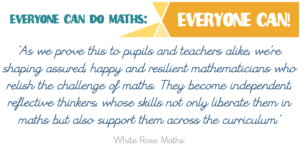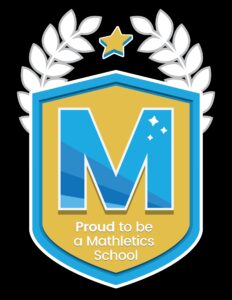 Mathematics at St. Anthony’s
Mathematics at St. Anthony’sAt St. Anthony’s, our intent is to provide children with a foundation for understanding number, reasoning, problem solving and logical thinking and to develop resilience, independence and enthusiasm in the subject, resulting in an ongoing positive relationship with number. Children will develop a secure and deep understanding of mathematical concepts and procedures and acquire automaticity and fluency, applying these skills across the curriculum and in everyday life. Our aim is for children to feel valued as part of a collaborative learning community with excellence and enjoyment at the heart of every lesson. Every child will be provided with an opportunity to shine and be successful, building self-esteem and a positive sense of wellbeing.
Aims
It is essential that the fundamental skills in Mathematics are secure and embedded and that all children, regardless of their starting point, maximise their academic achievement leaving St. Anthony’s Primary School with an appreciation and enthusiasm for Mathematics. Mathematics is a creative and highly inter-connected discipline that has been developed over centuries, providing the solution to some of history’s most intriguing problems. It is essential to everyday life, critical to science, technology and engineering, and necessary for financial literacy and most forms of employment. A high-quality mathematics education therefore provides a foundation for understanding the world, the ability to reason mathematically, an appreciation of the beauty and power of mathematics, and a sense of enjoyment and curiosity about the subject.
The national curriculum for mathematics aims to ensure that all pupils:
Mathematics is an interconnected subject in which pupils need to be able to move fluently between representations of mathematical ideas. The programmes of study are, by necessity, organised into apparently distinct domains, but pupils should make rich connections across mathematical ideas to develop fluency, mathematical reasoning and competence in solving increasingly sophisticated problems. They should also apply their mathematical knowledge to science and other subjects.
The expectation is that the majority of pupils will move through the programmes of study at broadly the same pace. However, decisions about when to progress should always be based on the security of pupils’ understanding and their readiness to progress to the next stage. Pupils who grasp concepts rapidly should be challenged through being offered rich and sophisticated problems before any acceleration through new content. Those who are not sufficiently fluent with earlier material should consolidate their understanding, including through additional practice, before moving on.
Curriculum overview
Our Mathematics Curriculum overview is included below:
Policies
Spoken language
The national curriculum for mathematics reflects the importance of spoken language in pupils’ development across the whole curriculum – cognitively, socially and linguistically. The quality and variety of language that pupils hear and speak are key factors in developing their mathematical vocabulary and presenting a mathematical justification, argument or proof. They must be assisted in making their thinking clear to themselves as well as others and teachers should ensure that pupils build secure foundations by using discussion to probe and remedy their misconceptions.
Mathematics in the Early Years
This involves providing children with opportunities to:
Numbers:
Shape, space and measures:
Key Stage 1- year 1 and 2
The principal focus of mathematics teaching in key stage 1 is to ensure that pupils develop confidence and mental fluency with whole numbers, counting and place value. This should involve working with numerals, words and the four operations, including with practical resources [for example, concrete objects and measuring tools].
At this stage, pupils should develop their ability to recognise, describe, draw, compare and sort different shapes and use the related vocabulary. Teaching should also involve using a range of measures to describe and compare different quantities such as length, mass, capacity/volume, time and money.
By the end of year 2, pupils should know the number bonds to 20 and be precise in using and understanding place value. An emphasis on practice at this early stage will aid fluency.
Pupils should read and spell mathematical vocabulary, at a level consistent with their increasing word reading and spelling knowledge at key stage 1.
Lower Key Stage 2- years 3 and 4

The principal focus of mathematics teaching in lower key stage 2 is to ensure that pupils become increasingly fluent with whole numbers and the four operations, including number facts and the concept of place value. This should ensure that pupils develop efficient written and mental methods and perform calculations accurately with increasingly large whole numbers.
At this stage, pupils should develop their ability to solve a range of problems, including with simple fractions and decimal place value. Teaching should also ensure that pupils draw with increasing accuracy and develop mathematical reasoning so they can analyse shapes and their properties, and confidently describe the relationships between them. It should ensure that they can use measuring instruments with accuracy and make connections between measure and number.
By the end of year 4, pupils should have memorised their multiplication tables up to and including the 12 multiplication table and show precision and fluency in their work.
Pupils should read and spell mathematical vocabulary correctly and confidently, using their growing word reading knowledge and their knowledge of spelling.
Upper Key Stage 2- years 5 and 6
The principal focus of mathematics teaching in upper key stage 2 is to ensure that pupils extend their understanding of the number system and place value to include larger integers. This should develop the connections that pupils make between multiplication and division with fractions, decimals, percentages and ratio.
At this stage, pupils should develop their ability to solve a wider range of problems, including increasingly complex properties of numbers and arithmetic, and problems demanding efficient written and mental methods of calculation. With this foundation in arithmetic, pupils are introduced to the language of algebra as a means for solving a variety of problems. Teaching in geometry and measures should consolidate and extend knowledge developed in number. Teaching should also ensure that pupils classify shapes with increasingly complex geometric properties and that they learn the vocabulary they need to describe them.
By the end of year 6, pupils should be fluent in written methods for all four operations, including long multiplication and division, and in working with fractions, decimals and percentages.
Pupils should read, spell and pronounce mathematical vocabulary correctly.
The link below will take you to the National Curriculum for mathematics and within this you will find the programmes of study for each year group.
PRIMARY_national_curriculum_-_Mathematics
Mathletics

Mathletics’. Mathletics is a targeted, rewarding and captivating online learning resource, which is aligned to curriculum standards. Your child has take-home access to Mathletics – they simply sign in with their school username and password (see below) using any compatible computer or mobile device.
We recommend that you spend time looking at the program with your child to explore how Mathletics will benefit his or
her learning. As a parent or carer, you can sign up to the Mathletics Family Centre. This will give you access to the learning content your child is foll
owing, and information regarding his or her progress within Mathletics.
To register for this service, you will need your child’s username and password:
To access the Mathletics Family Centre:
The extra Mathletics practice at home can make all the difference to your child’s progress. Encourage them to achieve a weekly target of 1000 points to earn a certificate, building through bronze, silver and gold across the school year. Go for gold! Further information and guides on Mathletics can be found under ‘Help’ in the Mathletics Family Centre.
Times Tables
We use a times table tracking system in school to assess children’s knowledge of times tables, at the end of each half term. Each year, from year 2 through to year 6 have specific times tables they must learn.
If a child achieves full marks, they move onto a more challenging assessment within the same set of times tables. Once a child has achieved full marks on three assessments, they are awarded a specific coloured badge, that relates to their year group, in assembly to signify that they have ‘mastered’ these times tables. A child will then complete extension assessments, still within the identified times tables, for their year group.
Only those children who have mastered their times tables, will begin on their new year group’s tables each September.
Our school also subscribes to Times Table Rock Stars. This is a system that the children use to practise the instant recall of their multiplication and division facts.
When it comes to times tables, speed AND accuracy are important – the more facts a child remembers, the easier it is for them to complete harder calculations. Times Table Rock Stars is a fun and challenging programme designed to help children master the times tables.
Research shows that daily practise is the best strategy for children to learn these important facts. Short bursts of daily practise are much more effective than spending hours once a week.
Parental support is critical in this area. For children to be fully motivated and for them to get the best out of the practice, they need an adult’s help. Without a Parent’s praise and reminders, without sitting down together or checking their work, practising times tables will not feel important.
Your child will have a unique Times Tables Rock Stars Login. To access from home, you can download the App on a tablet or phone, or view on a browser by following this link:
https://play.ttrockstars.com/auth/school/student